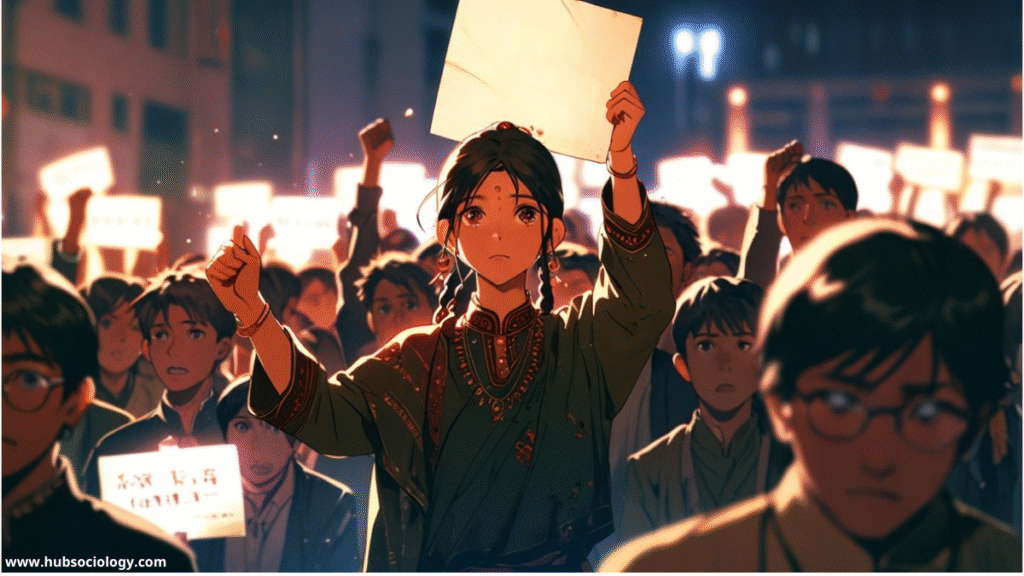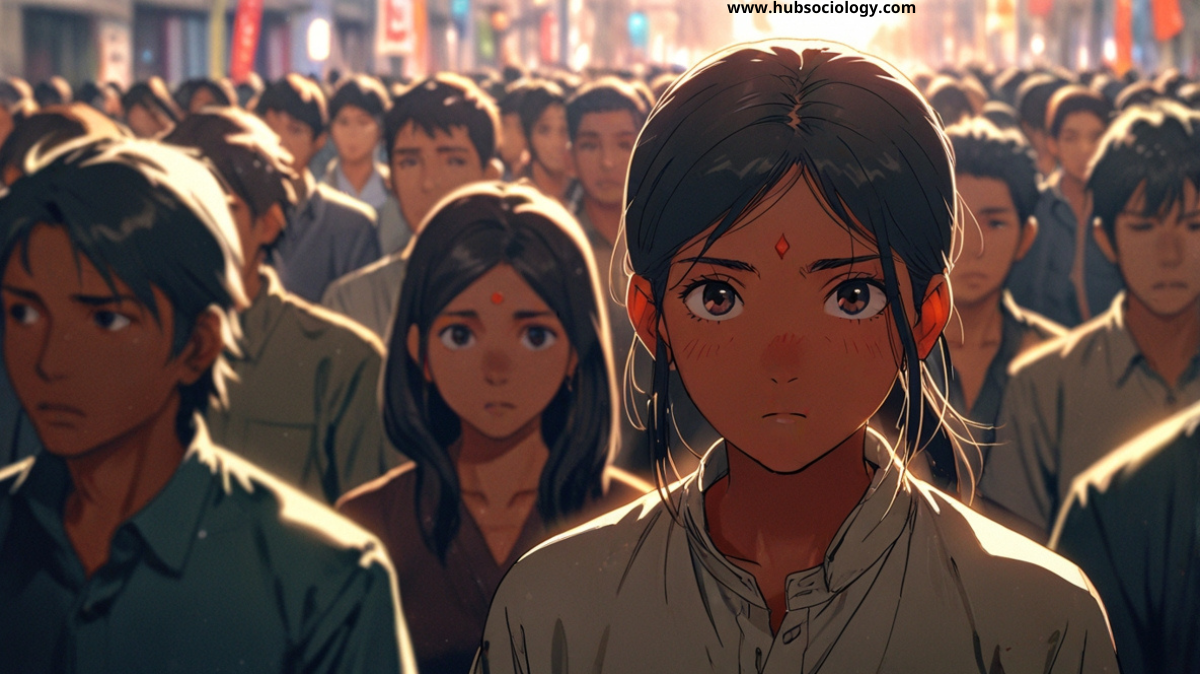Introduction on Women’s Movements in India
Women’s movements in India represent one of the most significant social movements in modern history, addressing questions of gender equality, social justice, and human rights. Rooted in the struggle against patriarchal structures, these movements evolved in tandem with broader socio-political changes—colonialism, nationalism, independence, modernization, and globalization. From fighting for basic education and legal rights to challenging deep-seated cultural practices and demanding political participation, women’s movements in India have reshaped the contours of Indian society. Examining them sociologically helps us understand not only the dynamics of gender relations but also how class, caste, religion, and globalization intersect with gender struggles.
Historical Background on Women’s Movements in India

The history of women’s movements in India can be divided into three broad phases:
- Colonial and Reformist Phase (19th–early 20th century):
During colonial rule, social reformers such as Raja Ram Mohan Roy, Ishwar Chandra Vidyasagar, and Jyotiba Phule challenged practices like sati, child marriage, and enforced widowhood. Reformist movements promoted women’s education, widow remarriage, and legal protection. Women leaders like Pandita Ramabai and Sarojini Naidu played a significant role in advocating for education and political rights. Here, the movement was shaped largely by male reformers, but it laid the foundation for later women-led activism. - Nationalist and Freedom Struggle Phase (1915–1947):
Women became active participants in the freedom struggle under the leadership of Mahatma Gandhi, who mobilized them for civil disobedience, salt satyagraha, and non-cooperation. Women like Kasturba Gandhi, Kamaladevi Chattopadhyay, and Aruna Asaf Ali not only joined protests but also took leadership roles. This participation gave women a sense of collective identity, though nationalist priorities often overshadowed women-specific issues. - Post-Independence Phase (1947 onwards):
After independence, the Indian Constitution guaranteed equality, non-discrimination, and affirmative action. Yet, the reality of persistent patriarchy, domestic violence, dowry deaths, and unequal opportunities triggered a new wave of feminist movements from the 1970s onwards. Organizations like the Self-Employed Women’s Association (SEWA) and campaigns like the Anti-Dowry Movement and Chipko Movement broadened the agenda of women’s struggles.
Sociological Dimensions of Women’s Movements
- Gender as a Social Construct:
Women’s movements in India challenge the patriarchal construction of gender roles, where women are often relegated to domestic and reproductive functions. Feminist sociologists argue that these movements deconstruct traditional roles, questioning the social norms that define “femininity” and “masculinity.” - Intersectionality of Caste, Class, and Religion:
Women’s struggles in India cannot be seen in isolation from caste and class. For instance, upper-caste women’s reform movements historically differed from Dalit women’s struggles against both caste oppression and patriarchy. Organizations like the All India Dalit Women’s Forum highlight how caste and gender discrimination are intertwined. Similarly, Muslim women’s movements around issues like triple talaq reflect the intersection of religion, gender, and law. - Collective Identity and Agency:
Women’s movements have been crucial in creating a sense of collective identity among women, transforming them from “victims” to “agents of change.” Participation in movements like the Chipko (tree-hugging) movement empowered rural women to assert their agency in environmental and community issues. - Changing Family and Marriage Patterns:
Feminist movements have questioned traditional family structures, demanding rights in marriage, inheritance, and property. Legal reforms such as the Hindu Succession Act (2005 amendment) reflect women’s struggles for equal rights within the family system. - Public vs. Private Divide:
Women’s movements blurred the boundaries between the “private” (family, home, sexuality) and the “public” (workplace, politics). Domestic violence, marital rape, and reproductive rights—once considered private matters—became public issues demanding legal and social attention.
Key Movements and Campaigns
- Anti-Dowry Movement (1970s–1980s):
Triggered by increasing dowry deaths and bride-burning cases, women’s groups organized protests demanding stricter laws. The Dowry Prohibition Act (1961) was strengthened through amendments, though enforcement remains challenging. - Anti-Rape Campaign (1980s):
The Mathura rape case (1972), where a minor tribal girl was raped by policemen, became a turning point. Women’s groups demanded reforms in rape laws, leading to significant amendments in the Indian Penal Code in 1983. - Chipko Movement (1973):
Initiated in Uttarakhand, women played a leading role by hugging trees to prevent deforestation. This movement demonstrated the link between women, ecology, and livelihood, emphasizing eco-feminism. - Self-Employed Women’s Association (SEWA, 1972):
Founded by Ela Bhatt, SEWA organized women workers in the informal sector, empowering them through microcredit, cooperative work, and labor rights. It showed how women’s movements could address economic marginalization. - Campaign Against Domestic Violence:
The Protection of Women from Domestic Violence Act (2005) was a result of years of campaigning by feminist groups. It expanded the definition of violence to include physical, emotional, sexual, and economic abuse. - Movements Against Sexual Harassment:
The Vishakha Guidelines (1997) and later the Sexual Harassment of Women at Workplace Act (2013) emerged from sustained feminist advocacy, recognizing workplace harassment as a violation of women’s rights. - Contemporary Movements:
- #MeToo Movement (2018): Sparked discussions on workplace harassment and gendered power dynamics in media, politics, and corporate spaces.
- Shaheen Bagh Protest (2019–20): Women, many from marginalized Muslim communities, emerged as the face of anti-CAA protests, highlighting women’s leadership in democratic struggles.

Challenges Faced by Women’s Movements
- Patriarchal Resistance: Deep-rooted patriarchal attitudes continue to resist gender reforms, often resulting in backlash against feminist activism.
- Fragmentation: Class, caste, and regional divisions sometimes weaken the unity of women’s movements. Urban, middle-class feminist concerns may not always align with rural or working-class women’s struggles.
- Institutional Constraints: While legal reforms exist, poor implementation and lack of awareness reduce their effectiveness.
- Globalization and Neoliberalism: Women face new challenges like labor exploitation in global markets, commodification of female bodies, and digital harassment, requiring movements to constantly adapt.
Impact on Indian Society
- Legal Reforms: Women’s movements have influenced progressive laws on dowry, rape, domestic violence, workplace harassment, and inheritance rights.
- Political Participation: Increased representation of women in local governance through the 73rd and 74th Constitutional Amendments (1992–93) was partly the outcome of feminist advocacy.
- Social Awareness: Issues once considered taboo—such as marital rape, menstruation, and sexuality—are now part of public discourse.
- Changing Gender Relations: Movements have challenged the male-dominated power structure, encouraging men to participate in conversations about equality and shared responsibility.
Sociological Theories and Women’s Movements
- Functionalist Perspective: Views women’s movements as a response to structural imbalances, seeking to restore equilibrium through reforms.
- Conflict Perspective: Highlights how women’s movements challenge power relations, questioning male dominance and economic exploitation.
- Feminist Theories: Liberal feminism focuses on equality in law and opportunities, radical feminism critiques patriarchal structures, and socialist feminism links gender oppression with capitalism. Indian feminist movements often combine elements of all three.
Conclusion on Women’s Movements in India
Women’s movements in India are not a single monolithic struggle but a mosaic of diverse experiences shaped by caste, class, religion, and region. Sociologically, they represent resistance against structural inequalities and the assertion of agency by women in redefining their roles in family, economy, politics, and culture. From reformist beginnings to contemporary globalized activism, these movements have significantly altered India’s social landscape.

Yet, challenges remain—gender-based violence, unequal pay, underrepresentation in politics, and patriarchal mindsets continue to hinder progress. Nevertheless, women’s movements in India embody resilience, creativity, and solidarity, making them a cornerstone of the country’s democratic and social transformation.
Do you like this this Article ? You Can follow as on :-
Facebook – https://www.facebook.com/hubsociology
Whatsapp Channel – https://whatsapp.com/channel/0029Vb6D8vGKWEKpJpu5QP0O
Gmail – hubsociology@gmail.com
Topic-related questions on Women’s Movements in India
5 Marks Questions (Short Answer Type)
- Define women’s movement in the sociological context.
- Mention any two major women leaders of the freedom struggle.
- What role did the Chipko Movement play in highlighting women’s agency?
- Write two challenges faced by women’s movements in India.
- What is the significance of the Mathura rape case (1972) in women’s movements?
10 Marks Questions (Medium Answer Type)
- Discuss the contribution of social reformers in initiating women’s movements during the colonial period.
- Explain how caste and class influence women’s movements in India.
- What role did SEWA (Self-Employed Women’s Association) play in empowering women workers?
- Examine the impact of globalization on contemporary women’s movements in India.
- Discuss the significance of the Anti-Dowry Movement in reshaping legal reforms.
15 Marks Questions (Long Answer Type)
- Trace the historical evolution of women’s movements in India from the colonial period to the present.
- Critically analyze the achievements and limitations of post-independence women’s movements in India.
- Explain the sociological dimensions of women’s movements with reference to intersectionality of caste, class, and religion.
- Discuss the impact of feminist theories (liberal, radical, socialist) on women’s movements in India.
- Evaluate the role of women in recent social and political protests (e.g., Shaheen Bagh, #MeToo movement) in shaping Indian democracy.
